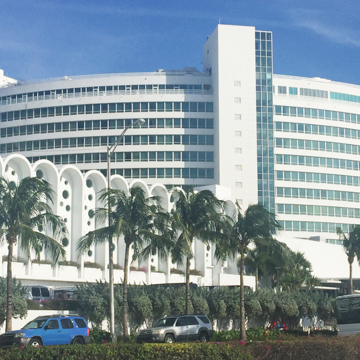On Sunday, December 19, 1954, the day before the Fontainebleau Hotel opened with an inaugural dinner dance to benefit the local Miami Beach hospitals of Mount Sinai and St. Francis, a Miami Herald staff writer marveled at the ubiquitous “colossal” aspects of the resort. After announcing the Fontainebleau’s $14 million price tag, he noted the hotel’s 565 rooms, 2,000 telephones, 847 staff members, and millions of dollars of European antiques, kitchen supplies, and guards. Two days after the opening, George Bourke, a movie reviewer for the Herald, wrote about the breathtaking experience of the place, noting that even a movie reviewer couldn’t spoil the expectation of the experience. In addition to noting the three-story cabana building, a roll-away dining room wall, and a dining patio with large windows onto the water in one of the pools, he also mentions the shopping center with a twenty-five-foot-wide “street” replete with a medical clinic.
The Fontainebleau finds its architectural roots, and ultimately its success, in two different grand Florida architectural traditions. On the one hand, the hotel clearly follows the legacy of the Ponce de Leon Hotel in St. Augustine and the Breakers in Palm Beach, drawing on the incredible machine-like precision that has come to be the defining characteristic of the hospitality industry. Morris Lapidus takes the blocky, mill-like structures that, in the older hotels, held long, double-loaded corridors leading to hundreds of identical rooms and here, bends it into a sleek, curved icon—a reference to the modern machine. One still sees the efficiency, but in a new language. On the other hand, Lapidus has taken a page from Addison Mizner’s Everglades Club and Joseph Urban’s Mar-a-Lago by creating within the lobby and other public spaces experiences that surprise and delight, and lose one within this entirely new resort environment. It is, perhaps, the formal gardens and classical details throughout the project that were intended to help the visitor make the connection between Miami Beach and the legendary wealth of Palm Beach, itself a dreamy confection of American interests in Europe. In contrast to the formal gardens, Lapidus’s playful inventions of waddles and Swiss cheese holes pointed to a new modern exoticism that was so readily rejected by the architectural establishment.
An architect with experience in retail, Lapidus was eager to incorporate commercial space into the Fontainebleau. Instead of developing shops on the street outside the hotel, as is the case with the Everglades Club in Palm Beach, Lapidus built the street right into the club, creating in the Fontainebleau a new hotel type that is part residence, resort, symbol, and city.
References
Bourke, George. “Building of Fontainebleau Packs a Wealth of Stories.” The Miami Herald,December 22, 1954.
Desilets, Deborah. Morris Lapidus. New York: Assouline Publishing, 2004.
Flynn, Stephen J. “Everything at Fontainebleau Hotel is Super Colossal.” The Miami Herald.December 19, 1954: 1-B, 1-C.
Friedman, Alice T. American Glamour and the Evolution of Modern Architecture. New Haven: Yale University Press, 2010.
Lapidus, Morris. Too Much is Never Enough: An Autobiography by Morris Lapidus.New York: Rizzoli International Publications, 1996.
Nepomechie, Marilys. Building Paradise: An Architectural Guide to the Magic City.Miami, FL: AIA Miami, 2010














